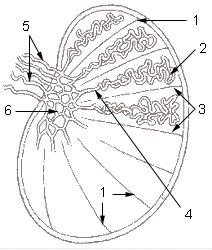Top Qs
Timeline
Chat
Perspective
Seminiferous tubule
Location of meiosis and creation of spermatozoa From Wikipedia, the free encyclopedia
Remove ads
Seminiferous tubules (Latin for "seed-bearing small tubes") are located within the testicles, and are the specific location of meiosis, and the subsequent creation of male gametes, namely spermatozoa.
This article needs additional citations for verification. (April 2025) |
Remove ads
Structure
The epithelium of the tubule consists of a type of sustentacular cells known as Sertoli cells, which are tall, columnar type cells that line the tubule.
In between the Sertoli cells are spermatogenic cells, which differentiate through meiosis to sperm cells. Sertoli cells function to nourish the developing sperm cells. They secrete androgen-binding protein, a binding protein which increases the concentration of testosterone.
There are two types: convoluted and straight, convoluted toward the lateral side, and straight as the tubule comes medially to form ducts that will exit the testis.
The seminiferous tubules are formed from the testis cords that develop from the primitive gonadal cords, formed from the gonadal ridge.
Remove ads
Function
Spermatogenesis, the process for producing spermatozoa, takes place in the seminiferous tubules. During spermatogenesis, the DNA of spermatogenic cells in the seminiferous tubules is subject to damage from such sources as reactive oxygen species.[1] The genomic integrity of spermatogenic cells is protected by DNA repair processes.[2] Deficiencies in the enzymes employed in these repair processes may lead to infertility.[2]
Remove ads
Additional images
- Longitudinal section through the left side of the scrotum and the left testis (seminiferous tubules visible in center, but not labeled).
- Seminiferous tubule (transverse section).
- Photomicrograph of section through rat testis, showing seminiferous tubules.
See also
References
External links
Wikiwand - on
Seamless Wikipedia browsing. On steroids.
Remove ads






